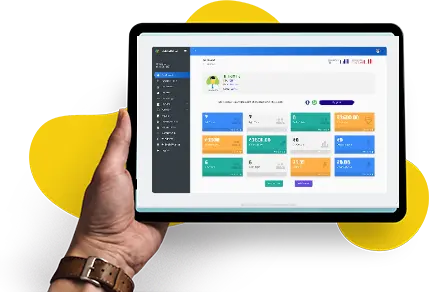Launching a business isn’t just about having a brilliant idea—it’s about creating a robust framework for success. Entrepreneurs who thrive don’t merely rely on passion; they strategically align their ventures with growth objectives, customer needs, and innovative solutions.
Starting a business requires taking steps forward to achieve growth, or you will revert back to safety. The same applies to MLM businesses, so let’s understand all about the MLM business model and dive deep into a step-by-step guide to successfully starting your own multi-level marketing company.
This Article Contains:
Understanding Multi-Level Marketing (MLM)
MLM, also known as network marketing, is a legitimate business strategy employed by some direct sales companies to sell products or services.
Companies use multi-level marketing (MLM) as a business model to encourage their independent business owners or distributors to actively recruit new members into their business. This recruitment process results in the creation of a hierarchical structure known as a downline.
Here’s how it works
Existing members (often called distributors) promote and sell the company’s products or services to others. They also recruit new participants into the business.
A distributor earns a percentage of the sales of their recruits.
Participants are encouraged to bring in new contractors, creating a network or downline.
Multi-level marketing is significantly different from traditional businesses. Let’s understand the difference between MLM and traditional business models to gain more clarity on their working:
After understanding the differences, one may ask how an MLM business model works.
An MLM Business Model: How Does it Work?
This complicated-looking business model, on the contrary, is simple and straightforward. Independent business owners reach out to interested individuals or members with a plan to create a win-win situation. Members who are interested in starting their own business and gaining financial freedom by being their own boss start their MLM business. Every individual involved in an MLM multi-level marketing is a business owner.
To understand how the MLM business model works one can think of a pyramid. The first independent distributor is hired directly by the direct marketing company. Let’s say in our example is Mr. A. Now, he recruits 5 more independent distributors who each turn around and recruit 5 more independent distributors, and so on.
Mr. A, as the sponsor or upline, recruits individuals into the multi-level marketing (MLM) company. These recruits, along with everyone they bring in, form his downline.
Also Read: Upline and Downline in MLM
Understanding the direction of these relationships is crucial because it directly affects the earnings within the pyramid. In most MLM setups, all distributors contribute a portion of their earnings both to the company and to those above them in the hierarchy.
Remember, clarity in these relationships ensures transparency and fair compensation for all participants.
Individuals starting their own MLM business can earn as follows:
An independent business owner's commission on sales.
Commissions from people who started their own businesses under them.
Individuals wishing to join the multilevel market may have to pay the registration fees. This may bring doubt about the legitimacy of MLM-based companies.
Getting Started with an MLM Business
As discussed above, the multi-level marketing model is different from the traditional business model. The traditional blueprint model won’t be much of a help when building an MLM business. So, let’s dive into the step-by-step checklist to get started and eventually build your MLM business.
1. Choose your Product/Service
The first step, without a doubt, must be choosing your product or service. The product should appeal to buyers and encourage distributors to sell further. For this, it becomes essential to identify, research, and test potential products and services that have a Unique Selling Proposition (USP) or are distinct from similar products/services.
Next, shortlist products or services that can deliver 5X value to your end customer compared to existing products/services and test the interest levels of your target customers and potential distributors.
The other crucial factor in choosing a product or service is strong customer demand to ensure sales success for representatives. As a result, your MLM company will also be able to generate profits from retail sales to consumers, rather than just recruiting representatives. Consider utilizing digital marketing services to gather the necessary data for this process.
2. Draw up a Detailed and Realistic Business Plan
In a multilevel market, this step is again crucial to the success of your MLM business. One might hit a dead end if proceeding without a detailed and realistic business plan. A plan will clarify how to proceed and define your business goals, purpose, and vision. Additionally, a well-crafted business plan can attract potential investors if external funding is required. But what are the key points that your MLM business plan must include?
Define business objectives
Define correct business objectives after researching your niche; they must be challenging yet realistic.
Analyzing the market
Develop sample profiles for your target customers and key competitors. Determine the size and opportunities of your niche market. Identify your product and service's fit in the market by compiling and analyzing the data. Make sure there are no potential barriers.
Profit and loss projections
Based on the financial goals, market research, product and operating costs, estimate your anticipated revenues, profits and losses for the first five years.
Sales and marketing
An effective sales and marketing plan should outline how to promote products and services to buyers, identify how many distributors are needed, and map out marketing strategies, website designs, and budgets.
It is important to note that the above list is not exhaustive, and more pertinent points can be added.
3. Construct a Compensation Plan
Once you have selected a product or service and created a business plan, the next step is to develop a compensation plan for your MLM company.
You will use this plan to lay the foundation for your direct selling business, defining the terms and conditions for earning income, commissions on direct sales, or as an override bonus earned on downline product sales.
It is essential to balance your compensation plan to ensure it is a win-win for all parties involved. The plan should be reasonable, attractive to distributors, and profitable for the company. This will help you develop a compensation plan that is fair, competitive, and sustainable for your MLM business.
4. Raise Funds for Your MLM Business
Commencing a multilevel marketing company without securing adequate capital is ill-advised. So it's important to raise funds. There are two common ways by which MLM companies raise funds in multilevel markets, i.e., debt financing and equity financing.
Debt Financing involves applying for and receiving an interest-bearing loan from institutions like credit unions, banks, or Non-Banking Financial Institutions (NBFIs). On the other hand, Equity Financing entails exchanging ownership stakes in the company for cash investments sourced from various entities, including family members, friends, and investors, or through Initial Public Offerings (IPOs).
One can employ a combination of these financing strategies based on your company's vision, unique requirements, and expansion plans. Ultimately, the most suitable approach should be determined by considering the multiple factors discussed, as well as maintaining a healthy debt-to-equity ratio.
5. Set up a Merchant Account
A merchant account enables businesses to accept debit and credit card payments and is like a business bank account. It can also be considered as a bridge between your business account and your customer bank account.
Setting up a merchant account for your Multi-Level Marketing (MLM) organization requires careful consideration. Thus, before applying for a merchant account, ensure the following steps are taken:
Identification
Confirm that the individual signing on behalf of the company meets the criteria for being a principal signatory, such as possessing good personal credit.
Website Presence
Enhancing your website with comprehensive information about your business and products can significantly impact payment processors' decision to collaborate with you.
Application Details
Before proceeding, inquire about the refund policy for setup fees, as some payment processors charge non-refundable application fees, regardless of account approval. It's crucial to clarify such details upfront.
Lead Time
Given the unpredictable growth patterns and legal complexities linked to MLM businesses, anticipate a longer approval process for a merchant account. Initiate the application early to allow ample time for approval before your business launch.
When applying for a merchant account, provide detailed information about your business, including chargeback ratios, return policies, and compliance with regulatory standards.
6. Select the Best MLM Software
MLM software is the backbone of your business, handling everything from compensation plans to automating API access, electronic transactions, party plan solutions, promotions, and more. It's crucial to choose software that can scale up or down depending on your current and future needs and provide end-to-end solutions.
Take the time to research different solutions and identify companies with published case studies and positive customer reviews.
Also Read: 12 Must-Have MLM Software Features to Drive Growth to Your Business
7. Hire an MLM Attorney
Having an experienced attorney taking care of the legalities is always a good idea. An experienced attorney can support you at the various stages of your MLM business. Their expertise can guide you on product regulatory compliance, labeling, compensation structure, and international expansion.
When your company sells products through distributors, it's important to ensure their claims about the products are accurate. The FTC oversees these claims and looks for any false or misleading information about how much money can be made or the health benefits of the products. Having an MLM attorney on your team means you have a knowledgeable resource who understands the current laws that regulate the direct selling industry.
Even if you think you don’t need an attorney, reality dictates that at some point in time, your company will need one. So, it is better to build an attorney-client relationship as a proactive step.
8. Keep all Your MLM Records
The policy and procedure manual is a fundamental document for an MLM company, encompassing a wide range of topics, usually 50 or more. It is tailored to your specific business model, products, principles, and ethics. Establishing clear and thorough documentation is essential for an MLM company. Policies and procedures, such as those outlined below, form the core of your business rules and operating processes.
Products and Marketing Materials
Make sure you protect your products and marketing materials, whether they are physical or digital.
Customer Data Protection
Comply with local and global privacy laws to safeguard customer data.
Compensation Structure
Ensure it aligns with actual sales to real customers, avoiding misrepresentations.
Compliance Considerations
Monitor and manage claims representatives make about products and earnings, staying compliant with federal law.
When developing documentation, avoid duplicating content from other companies. Instead, work closely with an MLM attorney to create customized templates or draft original documents specifically for your business. Keep in mind that while it might seem tedious now, meticulous documentation will benefit your company in the long run by reducing legal risks and protecting your brand reputation.
9. Prepare for the pre-launch
You're on the brink of success, but there's still more to uncover about your market, customers, and products. For this, you can conduct a pre-launch, also known as a soft launch, which is essentially a limited release of your product or service to a much smaller audience. You can take advantage of a pre-launch, and this can become a stepping stone to success for your MLM business. Because it can provide invaluable insights about your products from your target audience.
This phase, ideally initiated at least 90 days before the official launch, this period can be used to build awareness, interest, and even pre-orders. By leveraging strategies such as sneak peeks, promotions, and limited availability, you can validate your product, generate excitement, and lay the groundwork for a successful launch. Additionally, creating a pre-launch video tailored to your product's price point is an effective way to captivate potential customers and generate anticipation.
10. Get ready for the final launch of your MLM company
Now is the time to launch your MLM business, but before you launch it, you need to assess your success by revisiting your business goals. These goals will serve as Key Performance Indicators (KPIs) to evaluate the success of your launch. To ensure each KPI is measurable, break down each goal into quantifiable elements.
As you execute your launch, stay on top of your KPIs and supplement them with insights from your representatives and customers. This will help you validate your goals and make necessary adjustments quickly.
How to Grow Your MLM Business
To grow any business, the right plan of action is important. For this, we will cover the two fundamental pillars.
1. Select the Right Business Model
Choosing the right business model is crucial for your MLM enterprise, and there are several compensation frameworks to consider. The four most commonly used models are binary, matrix, uni-level, and stair-step breakaway.
The binary plan involves creating two lines of subordinates, with commissions based on the weaker leg's sales. The matrix plan has a limited-width strategy, with a specific number of distributors at each level. The uni-level plan is boundless in width and depth, with all distributors operating on the same level. The stair-step breakaway plan involves developing a team and establishing your crew after reaching a specific level.
When selecting an MLM compensation plan, consider your business goals and product. Your startup should provide a compensation scheme that benefits both the company and its distributors.
2. Solid Strategy and Team
To build a successful MLM startup, you need a solid strategy to hire dedicated and motivated individuals who believe in your product and vision. Above all, you need professionals who excel in network marketing and communication, as they will be responsible for promoting your products and recruiting others to do the same.
To hire the right professionals, start by identifying the positions you need to fill in your team. Then, recruit individuals based on their job profiles, skill sets, experience, and interview performance. During the interview, ask questions about their motivation for applying to the job to ensure they align with your vision and goals. There are various ways to find the right professionals, but it's essential to prioritize hiring individuals who share your passion and can help drive your business forward.
Final Words
Business is a dynamic landscape where every decision can either propel your company forward or slow it down. As a result, an entrepreneur's decision can mean the difference between exponential growth and stagnation for their business. Choosing an MLM software can be one of those decisions.
Global MLM Software is one of the best marketing systems. Whether you are a new or established company, our MLM software is easy to use and has an extensive suite of tools to help your business build and grow. With minimal customization, you can also get your business off the ground quickly.
FAQs
1. What are the common ways to raise funds for an MLM business, and which is more suitable?
MLM companies commonly raise funds through debt financing (interest-bearing loans) or equity financing (exchanging ownership stakes for cash investments). The most suitable approach depends on the company's vision, unique requirements, and expansion plans.
2. What is MLM, and how does it differ from traditional business models?
MLM, or multi-level marketing, is a legitimate business strategy where independent business owners sell products and recruit others, creating a hierarchical structure. Unlike traditional businesses, MLM relies on a commission-based structure and emphasizes individual sales.
3. How can I choose the right product or service for my MLM business?
Choosing the right product involves identifying, researching, and testing potential products with a Unique Selling Proposition (USP). Ensure the product appeals to buyers, encourages distributors to sell, and has a strong customer demand.






Comments
Leave a Reply
Your email address will not be published. Required fields are marked *